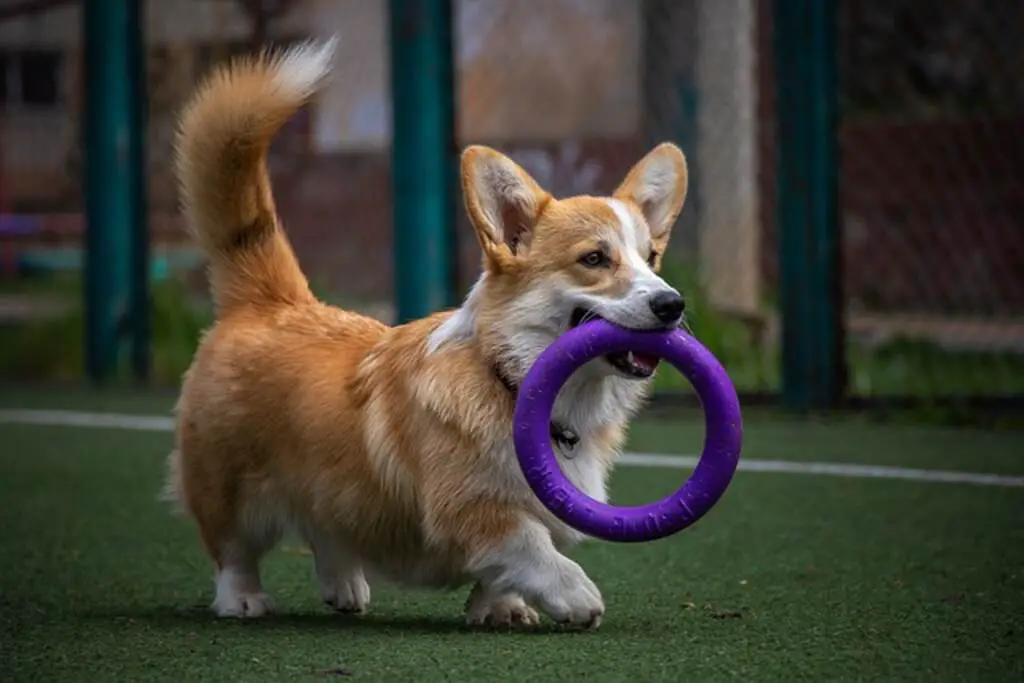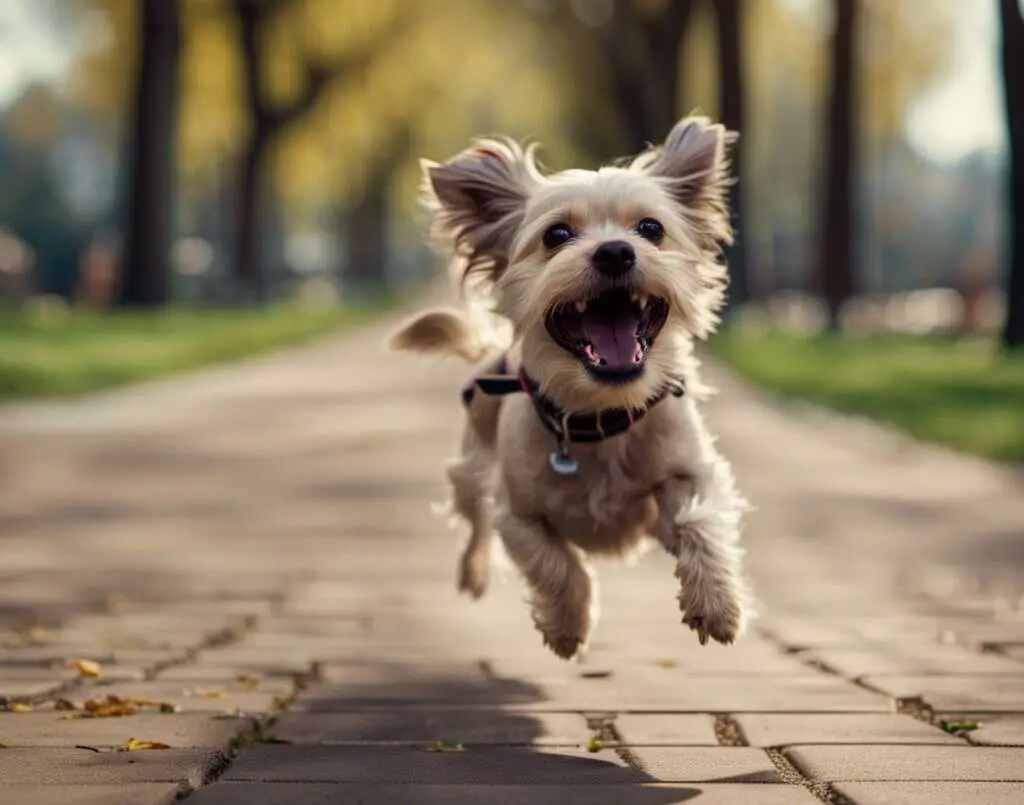As dog owners, we all want to ensure that our furry companions are healthy and happy. Exercise is an important part of their well-being, but how much running is too much for a dog? In this section, we will explore the topic of dog running limits and the potential risks of excessive exercise. It is crucial to find the right balance for your dog’s individual needs to prevent any harm to their health and happiness.
Understanding your dog’s exercise requirements is key to maintaining their physical and mental health. It is essential to consider the factors that may influence their exercise needs, including breed, age, and overall health. Monitoring your dog’s running intensity is also crucial to prevent over-exercise, which can cause significant harm to your pet.
Key Takeaways:
- Exercise is essential for a dog’s well-being, but it must be balanced to prevent harm.
- Finding the right balance requires considering individual factors like breed, age, and health.
- Monitoring your dog’s running intensity is crucial to preventing over-exercise and related risks.

How Much Running Is Too Much for a Dog?
While there is no specific universal time limit for how much running is too much for a dog, it’s crucial to consider the individual dog’s physical capabilities, breed, age, and overall health. Different dogs have varying exercise requirements, and what may be suitable for one dog might be excessive for another.
As a general guideline, adult dogs of most breeds can benefit from 30 minutes to 2 hours of exercise per day, depending on their energy levels and fitness. Puppies and senior dogs may require less vigorous exercise and shorter durations.
Keep a close eye on your dog during exercise. If they show signs of fatigue, excessive panting, or difficulty keeping up, it’s time to take a break. Providing access to water and avoiding exercise during extreme heat or cold weather is essential for your dog’s safety.
Ultimately, the best approach is to consult with your veterinarian. They can assess your dog’s specific needs and health status, and help you establish an appropriate exercise routine to keep your furry companion happy, healthy, and injury-free.
Signs of Over-Exercise in Dogs
While exercise is essential for a dog’s physical and mental health, it’s crucial to ensure they are not being over-exercised. Here are some signs that indicate your dog may be getting too much exercise:
- Excessive panting and labored breathing
- Lameness or limping
- Stiffness or soreness in muscles and joints
- Refusal to move or walk
- Vomiting or diarrhea
- Decreased appetite or lethargy
It’s also important to keep in mind that over-exercising can have serious consequences on a dog’s health. It can lead to dehydration, heat exhaustion, and muscle strains, among other issues.
“It’s important to keep an eye on your pet’s behavior and limit their running if they begin to show signs of fatigue or discomfort.”
If your dog is showing any of these signs, it’s essential to take a break from exercising and monitor their behavior closely. Consider consulting with a veterinarian for guidance on how to adjust their exercise routine to avoid over-exerting them.
Recommended Exercise Guidelines for Dogs
As a general rule, dogs need between 30 minutes to 2 hours of exercise every day, depending on their size, age, and breed. However, it’s important to tailor their exercise routine to their individual needs, as some dogs may require more or less activity than others.
Small Breeds: Small breeds such as Chihuahuas and Pomeranians typically have lower energy levels and may only require short walks or indoor playtime to meet their exercise needs. Aim for at least 30 minutes of exercise per day.
Medium Breeds: Medium breeds like Beagles and Border Collies require more exercise than small breeds, typically around 1 hour per day. This can include longer walks or runs, as well as interactive games like fetch or agility training.
Large Breeds: Large breeds such as Great Danes and Mastiffs have higher energy levels and require more exercise, typically around 2 hours per day. This can include brisk walks, hiking, or swimming.
It’s also important to adjust their exercise routine based on their age. Puppies, for example, may need shorter bursts of activity throughout the day to prevent overexertion. Senior dogs, on the other hand, may require less intense exercise and shorter walks. As always, monitoring your dog’s response to exercise is key to determining their individual needs.

Factors Influencing a Dog’s Exercise Needs
When it comes to determining a healthy running routine for your dog, there are several factors to consider. Understanding these factors can help you tailor an exercise regimen that meets your dog’s individual needs.
Energy Levels: A dog’s energy levels can vary significantly based on factors such as breed, age, and overall health. While some dogs have boundless energy and can run for miles without tiring, others may tire quickly and require frequent rest breaks.
Breed Traits: Different breeds have unique physical and behavioral characteristics that can influence their exercise needs. For example, breeds that were bred for herding or hunting may have a higher need for physical activity compared to breeds that were developed for companionship.
Overall Health: A dog’s overall health and physical condition will also play a role in determining their exercise needs. Dogs with chronic health conditions or injuries may require a modified exercise routine or even restricted activity levels.
To ensure your dog’s exercise routine is safe and effective, it’s important to monitor their running intensity and adjust their regimen as needed. By tailoring their exercise routine to their individual needs, you can help promote a healthy and happy lifestyle for your furry friend.
Understanding Your Dog’s Limitations
As a responsible pet owner, it’s crucial to understand that every dog has its limits when it comes to exercise. While some breeds may enjoy running for longer distances, others may show signs of fatigue and discomfort after a short amount of time.
It’s essential to monitor your dog’s behavior and recognize when they’ve reached their limit. Signs of over-exercise include excessive panting, drooling, stumbling, or slowed movements. If you notice any of these symptoms, it’s time to take a break and allow your furry friend to rest and recover.
Pushing a dog beyond its limits can lead to potential health risks, such as muscle strains, joint injuries, and even heat exhaustion. To prevent these dangers, it’s crucial to know your dog’s individual needs and limitations and adjust their exercise routine accordingly.
Recognizing Your Dog’s Signs of Fatigue
It’s vital to keep an eye on your dog’s behavior during exercise to recognize the signs of fatigue, such as slowing down or stopping altogether. Other signs include excessive panting and heavy breathing, stumbling, and difficulty walking or running.
If you notice any of these symptoms, it’s time to stop the exercise and provide your furry friend with a rest period. Be sure to offer plenty of water and a comfortable place to rest to help them recover.
The Risks of Over-Exercise in Dogs
“Over-exercise can have severe consequences for your dog’s health and well-being. It can lead to joint injuries, muscle strains, and even heat exhaustion, which can be life-threatening.”
Excessive running or exercise can strain muscles and joints, leading to long-term damage and reduced mobility. It can also cause heat exhaustion, especially during hot weather, which can be fatal if not treated promptly.
It’s essential to monitor your dog’s exercise routine and adjust it based on their response and physical limitations. A healthy exercise regimen should provide your dog with the necessary activity while preventing any potential risks to their health and well-being.
Balancing Rest and Activity
A balanced approach to exercise is essential for keeping your dog healthy and happy. Along with regular activity, it’s important to incorporate rest periods into your dog’s routine to prevent over-exercise and injury.
When planning your dog’s exercise regimen, aim for a mix of aerobic exercise, such as running or playing fetch, and muscle-building activities, such as agility training or hill climbing. It’s also important to consider your dog’s individual needs, including their age, breed, and energy level.
One way to strike the right balance is by following the recommended exercise guidelines for dogs. As a general rule, adult dogs should get at least 30 minutes of aerobic exercise each day, while puppies and senior dogs may require less. However, these are just guidelines, and it’s important to monitor your dog’s response to exercise and adjust accordingly.
One way to ensure you’re not over-exercising your dog is by monitoring their running intensity. Signs of over-exercise may include excessive panting, difficulty breathing, and reluctance to continue running or playing. If your dog is exhibiting these signs, it’s important to take a break and rest.
Remember, every dog is different, and it’s important to tailor their exercise routine to meet their individual needs. By finding the right balance between rest and activity, you can help keep your furry friend healthy, happy, and full of energy.
Tailoring Exercise to Your Dog’s Individual Needs
Every dog is unique, and their exercise needs can vary depending on their individual traits. To create a healthy and effective exercise routine, it is essential to tailor it to your dog’s specific needs. Here are some tips on how to assess your dog’s fitness level and adjust their exercise regimen:
- Consider your dog’s breed: Different breeds have different energy levels and exercise requirements. For example, a border collie may need more exercise than a bulldog.
- Take your dog’s age into account: Puppies and senior dogs may not be able to handle as much exercise as adult dogs.
- Observe your dog’s behavior: Does your dog seem tired or sluggish during and after exercise? Or do they seem energized and ready for more?
- Monitor your dog’s response: Watch for signs of fatigue or discomfort, such as excessive panting, limping, or reluctance to continue running.
By assessing your dog’s fitness level and adjusting their exercise routine accordingly, you can ensure that they are getting the appropriate amount of exercise for their needs. Remember to always monitor their response and adjust the intensity and duration of their running as necessary to prevent over-exercise.

The Role of Breed and Age in Exercise Requirements
Different dog breeds and life stages have varying exercise requirements. It is essential to consider these factors when developing a healthy exercise routine for your pet.
For example, high-energy dog breeds like border collies, Australian shepherds, and Jack Russell terriers may require more exercise than low-energy breeds like bulldogs, pugs, and basset hounds. Similarly, puppies and young dogs require less intense exercise than adult dogs since their bones and joints are still developing. Senior dogs may also require less exercise and more rest periods due to age-related health issues.
It is important to consult with your veterinarian to determine the specific exercise needs and limitations of your dog based on their breed and age. Regular health check-ups can help identify any underlying health issues that may impact your dog’s ability to exercise.
By understanding the exercise requirements of your dog, you can ensure that they receive the appropriate level of physical activity to maintain their health and happiness.
Monitoring and Adjusting the Exercise Routine
Monitoring your dog’s running intensity is crucial to ensure they are not over-exercising. Pay attention to their breathing, heart rate, and overall behavior during and after their running sessions. Signs of exhaustion or discomfort can indicate that the exercise routine needs to be adjusted to meet their individual needs.
It’s important to gradually increase the intensity and duration of their exercise routine over time. Pushing your dog too hard too quickly can lead to injuries or other health problems. Start with shorter, low-intensity runs and gradually build up as your dog’s fitness level improves.
Remember to always listen to your dog and adjust their exercise routine accordingly.
If you notice any signs of fatigue or discomfort, it’s important to give your dog a break and allow them to rest. Incorporating rest periods into their exercise routine is essential to ensure they stay healthy and happy.
Additionally, consider varying the types of exercise you provide for your dog. Mixing up their routine with activities like running, walking, or playing can help keep them engaged and prevent boredom or burnout.
By monitoring and adjusting your dog’s exercise routine, you can ensure they receive the optimal amount of physical activity for their health and well-being.
Conclusion
As a responsible dog owner, it’s crucial to understand your furry friend’s exercise requirements and limitations. Running is an excellent way for dogs to burn off energy and stay healthy, but it’s important to find the right balance.
In this article, we discussed the dangers of excessive running and the signs of over-exercise in dogs. We also provided general guidelines on how much exercise different breeds and age groups typically need. However, it’s important to remember that these are only guidelines, and each dog is unique in their individual needs.
Tailoring Exercise to Your Dog’s Individual Needs
It’s crucial to tailor your dog’s exercise routine based on their individual needs. This involves monitoring their response to exercise and adjusting the intensity and duration accordingly. It’s also important to consider their breed, age, and overall health when determining their exercise routine.
The Role of Rest and Activity
A balanced approach to exercise involves incorporating rest periods into your dog’s routine. This helps prevent injuries and allows their muscles to recover. Finding the right balance between activity and relaxation is key to providing a healthy and enjoyable exercise routine.
Overall, understanding your dog’s exercise requirements and limitations is essential in providing them with a healthy and happy life. By finding the right balance of exercise, rest, and individualized care, you can help your furry friend thrive.

FAQ
What are the signs of over-exercise in dogs?
Signs of over-exercise in dogs include excessive panting, difficulty in breathing, reluctance to continue exercising, limping or lameness, and signs of exhaustion. It is important to recognize these signs and modify the exercise routine accordingly.
What are the recommended exercise guidelines for dogs?
The recommended amount of exercise for dogs depends on their size, breed, and age. Generally, dogs should engage in daily exercise that includes both physical activity and mental stimulation. It is important to consider their individual needs and consult with a veterinarian for specific recommendations.
What factors influence a dog’s exercise needs?
Several factors influence a dog’s exercise needs, including their energy levels, breed traits, overall health, and age. It is important to consider these factors when developing an exercise routine to ensure it aligns with their capabilities and prevents over-exercise.
How can I understand my dog’s limitations when it comes to running?
Understanding your dog’s individual limitations requires observation and recognizing signs of fatigue or discomfort. It is crucial to know when your dog has reached its limit and avoid pushing them too far. Over-exercise can lead to injuries and health issues.
How do I balance rest and activity for my dog?
Balancing rest and activity is essential for a healthy exercise routine. Incorporating rest periods into your dog’s routine allows their muscles to recover and prevents over-exhaustion. Finding the right balance between activity and relaxation is important for their overall well-being.
How can I tailor my dog’s exercise routine to their individual needs?
Tailoring your dog’s exercise routine involves assessing their fitness level, adjusting the exercise regimen accordingly, and recognizing any limitations they may have. Every dog is unique, and it’s important to consider their specific needs and abilities when planning their exercise routine.
How does age and breed affect a dog’s exercise requirements?
Age and breed play a significant role in determining a dog’s exercise requirements. Puppies and young dogs may have more energy and require more exercise, while senior dogs may need a more gentle approach. Different breeds also have varying exercise needs based on their energy levels and breed traits.
How do I monitor and adjust my dog’s exercise routine?
Monitoring your dog’s exercise routine involves observing their response, monitoring signs of fatigue or discomfort, and adjusting the intensity and duration of their running accordingly. It’s important to be attentive to their needs and make modifications as necessary to ensure their well-being.
What should I remember about running limits for dogs?
It is important to find the right balance when it comes to running limits for dogs. Excessive running can lead to over-exercise and potential harm. Knowing your dog’s individual limitations, monitoring their response, and providing a healthy and enjoyable exercise routine are key to their overall health and happiness.


